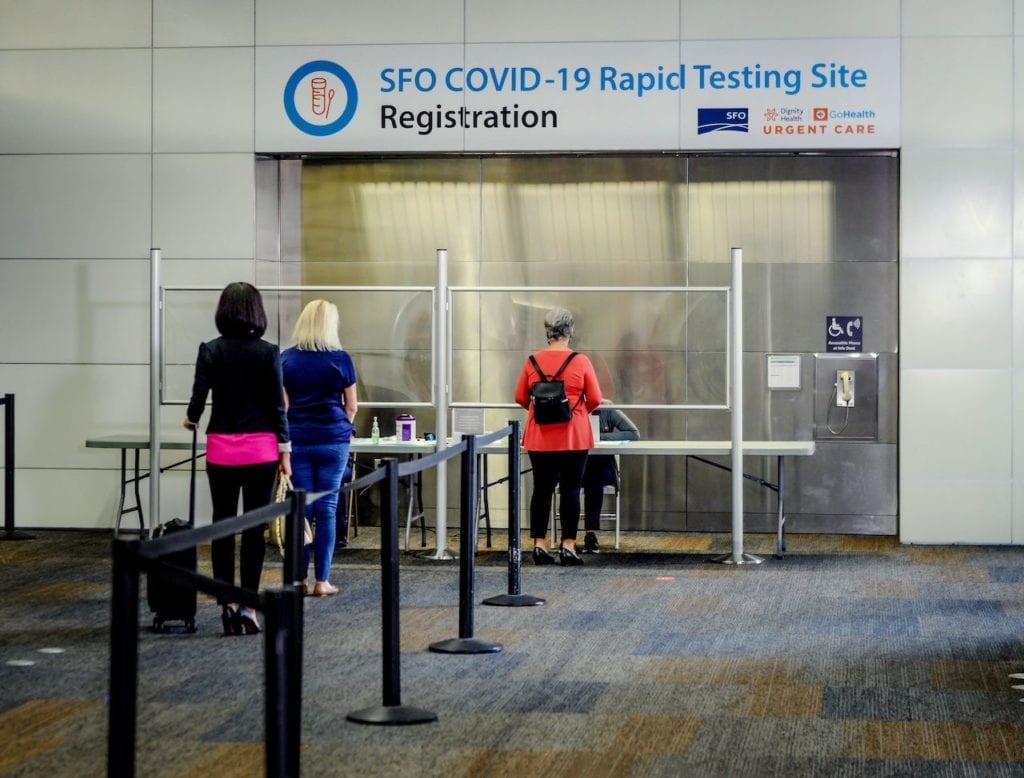This week United Airlines announced it will offer free COVID-19 tests on a trial basis for some trans-Atlantic flights. Is this the antidote to the airline’s COVID-19 travel woes?
United Offers COVID-19 Tests to London
United announced that the carrier is creating a COVID-19 negative flight, in theory. The carrier will offer the tests free of charge for passengers on specific flights from Newark (EWR) to London-Heathrow (LHR.) The pilot program will run from November 16th to December 11th. Any passengers who wish not to test will not be permitted on the flight and alternate flight arrangements will be made.
The parameters are rather specific, here are the details:
- Only offered on EWR-LHR flight UA 14
- Operates Mondays, Wednesdays, and Fridays
- Tests must be scheduled at least three hours prior to departure
- The Rapid Tests are conducted in the Newark United Club near C93
- Children aged two and under are exempt

Free Tests Are a Good Investment
United charged Hawaii-bound customers to conduct tests if the customer did not pursue one on their own. Requirements for flights to the state dictated a negative COVID-19 test within 72 hours of arrival in order to avoid a 14-day (highly enforced) quarantine. The cost of the tests through the carrier ranged from $80-250. The carrier reports that passenger loads to the islands increased 95% upon offering the tests at the passenger’s cost.

By including the test on trans-Atlantic flights, it reduces the cost and burden for the customer and takes out the guesswork for the airline.
If Hawaii flights saw such a substantial increase when customers had to pay for the tests and make arrangements for themselves (in some cases), how much more likely are passengers to buy a ticket when the test and inconvenience is handled for them?
United shareholders may see the tests as an expense the airline can ill-afford at a time where the carrier is continuing to lose $25MM every single day – a vast improvement over previous quarters. But this is also likely a situation where United can ill-afford not to invest in anything that will enable travelers to get back in the sky.
It’s also a great choice for test market for two reasons. First, American and its joint venture partner, British Airways, had such substantial frequencies prior to the pandemic that they all-but owned the most lucrative air markets in the world. To British Airways alone, the London Heathrow-New York JFK route was worth more than a billion dollars annually. United could end up with a greater market share of the lucrative route.
Second, demand should easily rise given that around 200,000 Americans live abroad in England and may want to return to the states for some time given the increasing lockdown measures in the UK. The pilot period also falls over the busiest travel season traditionally in the United States, the Thanksgiving holiday. With success, the pilot may be extended over the Christmas and New Year holidays as well, I presume.
Most importantly, it gives United a unique marketing advantage. Much as other carriers utilized the elimination of middle seat sales, United can uniquely position itself in the long haul market with an edge on safety.
Is This The Answer Both Countries Are Looking For?
The UK and US had discussed a travel corridor to allow residents from both countries to safely move back and forth without lengthy quarantine periods that make travel less practical. That plan has been shelved for the time being as the UK has experienced an increase in cases (as has the US and the rest of Europe.)
The pilot program will also serve as a real world environment in which the efficiency of the model for the long term and broader roll out can be measured. Three flights weekly is limited considering the tremendous trans-Atlantic network of not only United but the rest of the carriers as well.
Demand is low now and while traffic is increasing, we are likely a long way from a resumption of near shuttle service between the London and New York markets. However, this could be a model for offering at least one daily flight between countries as they continue to grapple with the COVID-19 global pandemic.

Conclusion
This is a really smart move for a number of reasons for United. It’s a potential land grab (until other carriers catch up) for the lucrative New York-London market. It also gives the carrier a chance to restart more expensive long haul flights. The airline continues to fly many of these routes as cargo operations, it would be beneficial to utilize the cabin as well.
What do you think? Is United’s free test plan the right answer? Would you be more likely to travel for business or leisure under this process?

